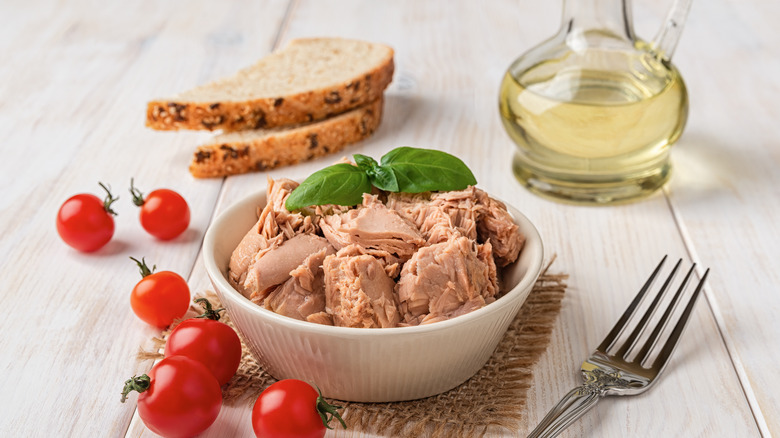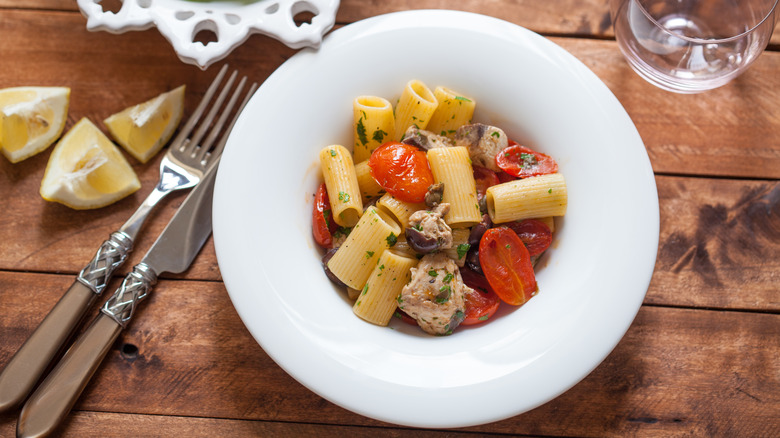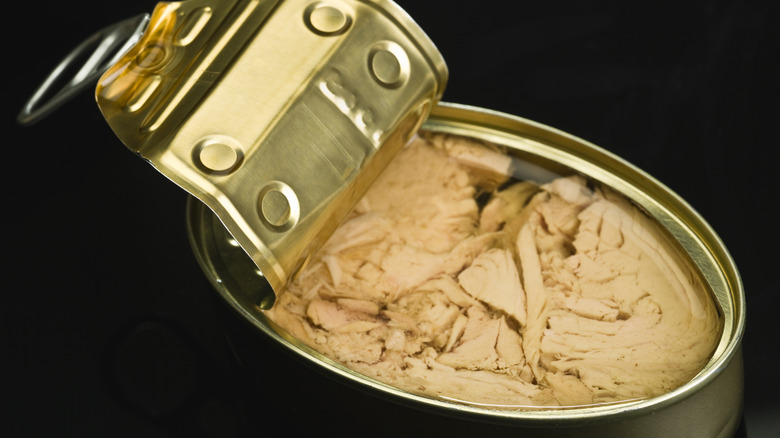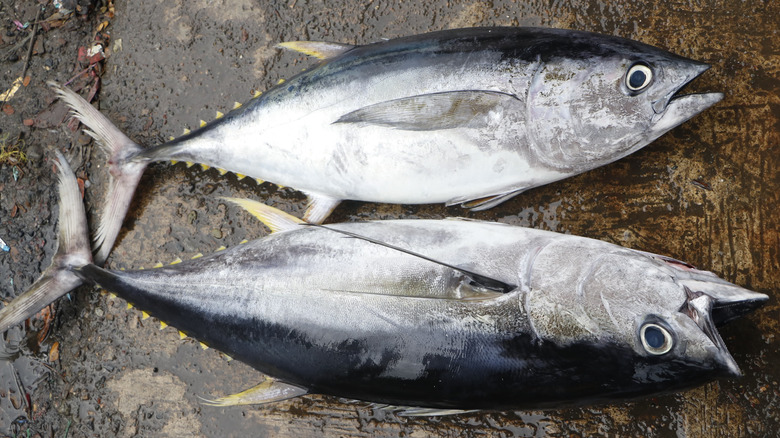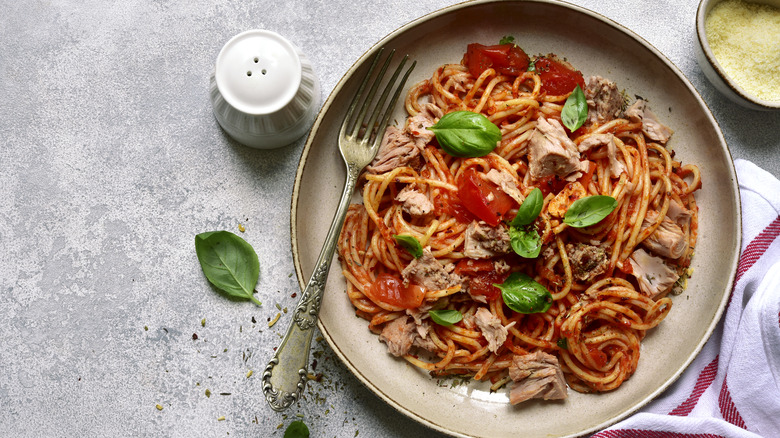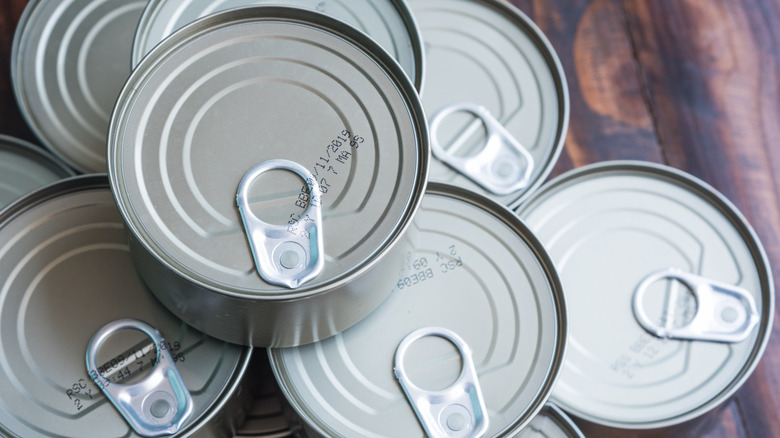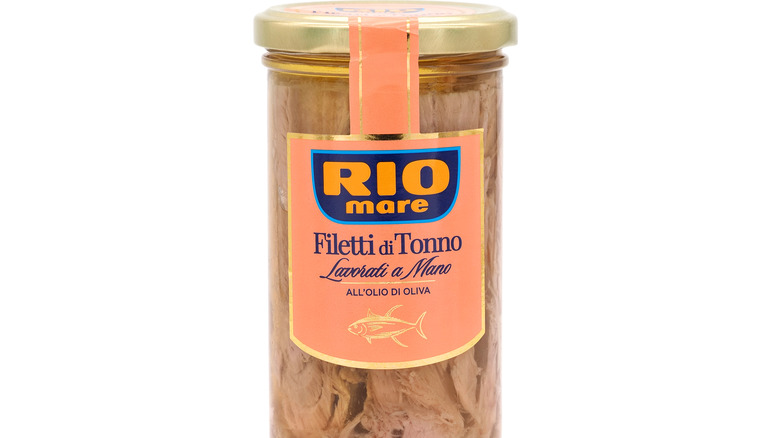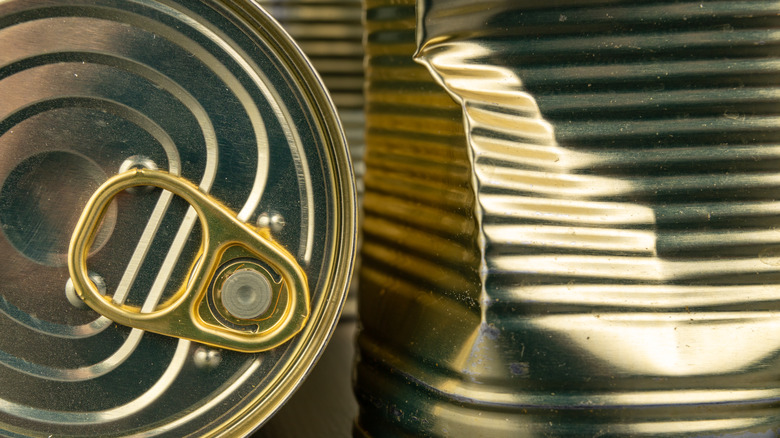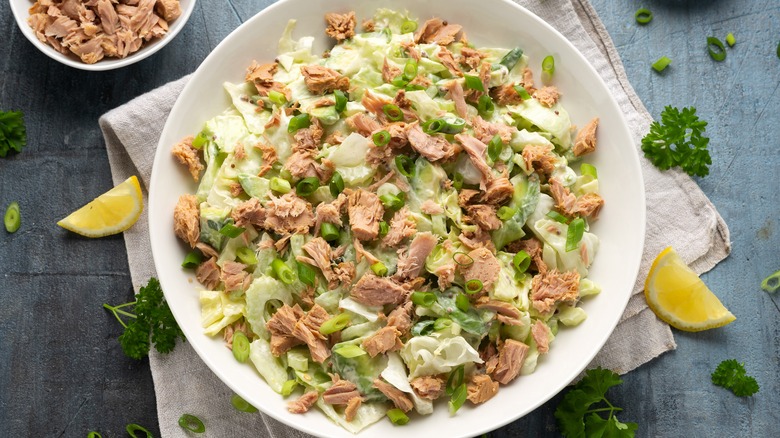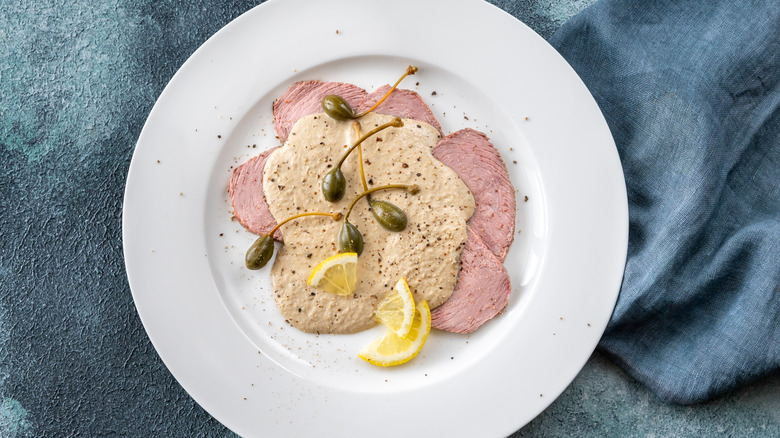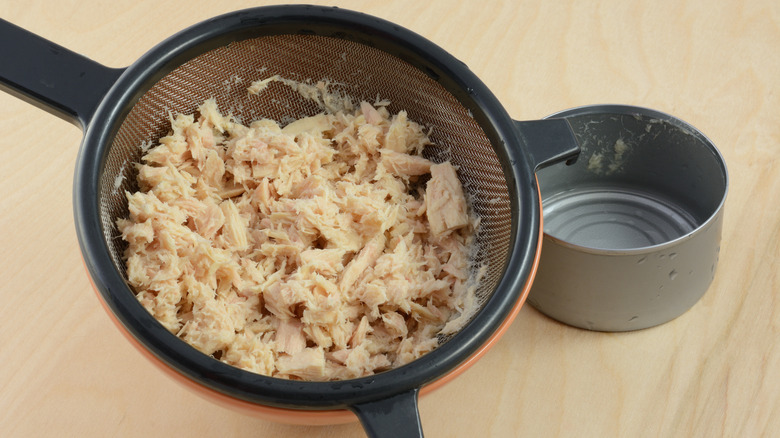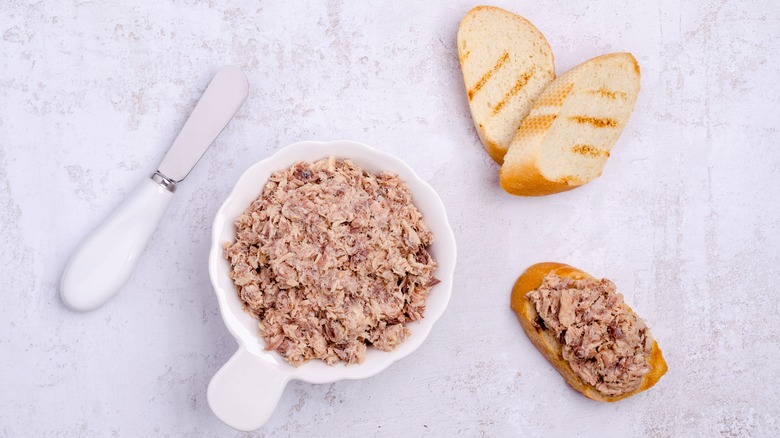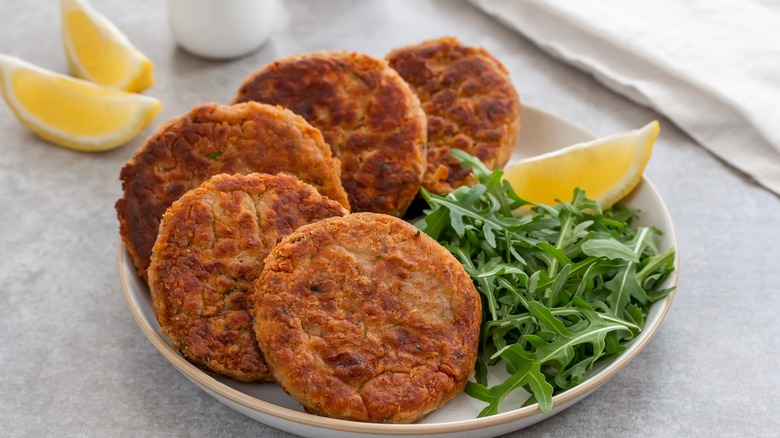Mistakes You Have To Stop Making With Canned Tuna
We may receive a commission on purchases made from links.
Folks often debate the best and worst canned foods, but if you ask us, canned tuna has to take top marks. Of course, part of canned tuna's enduring appeal lies in its versatility. The whole point of canned tuna is that it offers a no-brainer dinner option when time, energy, and money are in short supply. You can make a creamy tuna salad or an epic tuna sandwich in a flash, and you can trust that it packs a protein punch. Even still, you might be under-thinking this delicious pantry staple.
For instance, have you ever considered changing up what brand you buy or how you typically store your canned tuna? If you've never asked yourself these questions, you may be making a huge misstep with this underrated protein. Below, we show the mistakes you may be making with this humble pantry hero, from forgetting to pair it with complementary flavors to neglecting to mix it into your favorite pasta sauce.
Not adding tuna to your pasta
When it comes to canned tuna, many home cooks turn to the same few dishes, like tuna salad or tuna melts, but that scope is too narrow for this versatile fish. For a little expert help, consider some sage advice that chef and "Chopped" judge Marc Murphy gave to Tasting Table: Add tuna to your pasta dishes. This isn't a pasta salad hack, either. Rather, Murphy suggested you create a delicious warm pasta dish complete with canned tuna.
To add flavorful nuance to the dish, Murphy suggests adding in a bit of acid in the form of capers or lemon juice and a dash of heat — from red pepper flakes to hot sauce or chili crisp, it's all up to you. Taking it a step further, he also suggested adding some fresh tomatoes to the mix to create a rich, summery sauce. You can also take your pasta dish in a richer direction by creating a butter-tuna sauce for the deeply savory spaghetti tonno e burro. Once you start adding tuna to your pasta, you'll find that the options are endless (and if you're like us, you'll never get bored of having a more protein-filled dish).
Forgetting about tuna in olive oil
Canned tuna is typically packed in one of three liquids: water, brine, or oil. Though your instinct may be to reach for the tuna packed in water, as it's often cheaper and promises fewer calories, consider trying the oil option. Tuna in olive oil may pack a few more calories, but it's more than worth it for the boost in texture and taste you get. This moister, tastier version of tuna will be the superior option when mixing it into pasta, salad, or tuna cakes or enjoying all on its own with crackers. In fact, in our ranking of over a dozen canned tunas, the tunas in olive oil took the highest marks.
Admittedly, this oil-packed option won't work for every tuna recipe. This is especially true for tuna salad, where it's going to be incorporated with mayonnaise or oil to make it moister — too much oil or contrasting oil flavors can be off-putting. But for many other culinary adventures, tuna in olive oil is the superior choice.
Only buying skipjack tuna
Surveying a typical can of tuna, you may notice it lists either skipjack, albacore, or chunk light tuna on its label. Skipjack and chunk-light tuna are essentially the same thing, comprising a fishy, salty tuna that satisfies most buyers. Albacore is the milder option of the two, with it being whiter and boasting a less fishy flavor. But there are more than just skipjack and albacore tuna varieties out there.
First up, consider trying yellowfin tuna, a variety with a richer fishy flavor akin to skipjack. In fact, yellowfin and skipjack occasionally get mixed together to create the aforementioned chunk light tuna, so chances are you've already tried yellowfin tuna without knowing it. For a less fishy taste, you can try tongol or bigeye tuna, which can both provide mildly sweet and meaty tuna filets. If you want the crème de la crème, find ventresca (fillets of tuna belly that are richly marbled), which is often sold jarred with olive oil. Though this is a pricier form of canned tuna, its rich flavor and taste will set it far apart from any other variety, making it well worth the splurge.
Not searching for sustainable options
The word "sustainability" is seen pretty much everywhere now, but it can feel like a loaded term in the grocery aisle. What does it really mean for the environment, and how can you tell if the can you're holding really delivers on its promise? Well, when it comes to canned tuna, a brand that promises its fish has been sustainably caught and harvested means that it uses ethical and ecologically safe methods of fishing. Some fishing methods, like using giant nets, lead to catching juvenile schools of fish, turtles, sharks, and, yes, even dolphins. Overfishing and reckless practices like this lead to an ocean depleted of resources, which spells ecological trouble and shortages for future generations.
So, how can you tell if your tuna is making strides for a sustainable future? Look for terms like "line and pole-caught" or "troll-caught." Both methods have fish caught separately, rather than just with one big net, allowing fishermen to discern tuna ready for canning and other sea creatures. Another good sign is if the can has a Marine Stewardship Council (MSC) label depicting blue fish. The MSC evaluates companies for their commitment to eco-friendly practices, doling out certifications when they've proven that they're devoted to sustainable fishing. Do note that "dolphin-safe" labels don't intrinsically mean that the tuna has been sustainably caught — this label has nothing to do with sustainable fishing practices.
Forgetting to add tuna to your marinara sauce
We've already extolled the virtues of adding tuna to pasta, but what about adding this delicious protein directly to pasta's favorite sauce? In this case, imagine what a bit of canned tuna can bring to marinara sauce. Imparting an umami richness and protein heft, tuna can elevate both homemade tomato sauce and your favorite store-bought variety.
To take full advantage of this idea, make sure to use quality tuna packed in oil, as the taste and texture of your tuna will really stand out in this dish. And don't stop with just adding tuna. For instance, consider adding some chopped Italian herbs like parsley, thyme, and basil or a dash of lemon juice to brighten things up. If you still think it needs something extra, try adding an extra salty, briny note via anchovy paste, diced capers, or even chopped olives. Finally, remember that the acidic nature of tomatoes can make the sauce too astringent, so consider balancing it out with a teaspoon or two of granulated sugar.
Improperly storing your tuna
Canned tuna is shelf-stable, but that doesn't mean it can't spoil if improperly stored. Back in the day, pantry items were often stored in root cellars or larders, a naturally cold and dark place thanks to being built underground. Today, pantries are often located mere steps from the kitchen, putting it closer to heat and humidity. Remember: If you get hot when you use your oven, your pantry items probably do, too. This mixture of heat and humidity (plus direct sunlight) can spoil your canned tuna. If you keep your thermostat constant and have a pantry located safely away from your oven's heat, you can store your canned tuna in the pantry, but you shouldn't store them in cupboards near the stove.
You should also make sure you're not piling on heavier items, like a tower of additional cans. Under pressure, tin cans can buckle and occasionally pop, exposing them to air, so it's better not to test their strength. If you've invested in an expensive canned tuna, you're safest bet is to store your unopened fancy tuna in the fridge and prioritize it higher than your room-temperature cans. As tuna's often stored in short tins, these won't take up too much refrigerator real estate, thankfully.
Ignoring gourmet brands
When shopping at the grocery store, you're guaranteed to run into the usual tuna brands: StarKist, Bumblebee, Chicken of the Sea, etc. While these household names definitely work in a pinch, perhaps it's time you explore some of the more luxurious tuna brands out there. If you shop online, you can get access to high-quality brands from Spain, Portugal, and Italy at moderate price points.
Why these specific countries? In Portugal and Spain, canned seafood, also known as conservas, is an art form, so this kind of canned tuna will have a superior taste. For example, there's Conservas Ortiz from Spain and Bom Petisco from Portugal. Italy, too, has a long and illustrious history of canning tuna, and the country has a special way of preserving it, marinating the tuna in oil for the most luxurious flavor (Rio Mare is a popular Italian option). The United States has some highly recommended gourmet brands as well, with several top chefs calling out American Tuna for its great flavor and sustainability practices. Long story short, if you want to experience tuna in a new way, try a luxury brand or two.
Purchasing dented or damaged cans
Though the tin cans that tuna is packed in are sturdy, they're not completely invulnerable. That being the case, you can expect to stumble across the odd dented or crushed can of tuna at the store. Blemishes happen, but if possible, try to avoid damaged cans. This might sound a bit fussy, but keep in mind that this directive comes straight from the U.S. Department of Agriculture.
Once a can is deeply dented along the seam, there's a chance that air can get in, which will lead to spoiling. Shallow dents may not cause as much worry, but be wary of anything that seems to damage the can close to its seam (the more vulnerable top section that you would open). Now, you may be wondering how you can tell if you're looking at a deep dent. Normally, they'll be so dented that they have sharp edges exposed. For the safest can of tuna, reach for one lacking any blemishes.
Not pairing your tuna with lemon
Even the most fervent of tuna fans must admit to its one shortcoming: Canned tuna doesn't smell that good. After all, this is one notorious reason it can get banned from the break room at work. Luckily, the queen of pasta herself, Nadia Munno, told Tasting Table that there's a surefire way to eliminate that pesky odor. Her solution? Use a spritz of lemon juice to help alleviate that fishy canned tuna smell.
As she told Tasting Table, Munno squeezes a whole lemon over her tuna after opening the can and draining it. Then, she blends it all together. While working as a practical way to neutralize that fishy odor, citrus is also a natural, tasty pairing for tuna. For the best results, try using this hack with recipes where the tuna really stands out, like in a Niçoise salad. Or, you can use it like Munno does and incorporate it into a puttanesca pasta dish.
Neglecting to turn your tuna into a sauce
Those who love to put canned tuna in their pasta have another way to use their tuna in a uniquely Italian way. As "Top Chef" star Buddha Lo told Tasting Table, one of the best uses of canned tuna is to turn it into a creamy sauce called vitello tonnato. Often paired with cold veal cutlets, vitello tonnato is typically prepared with anchovies, canned tuna, lemon juice, oil, and mayonnaise. As Lo noted, "The tinned tuna gives so much umami, it becomes almost anchovy-like."
Though the sauce is traditionally ladled over meat, you could just as easily use it for any other purpose, including letting it coat your noodles as-is. Lo likes to drizzle it on tuna tartare or work as a creamy dressing on sandwiches. It would also work well as a nice topper for pan bagnat (a type of French sandwich featuring Niçoise salad between slices of wheat bread), in fact. Alternately, you can serve this creamy condiment with fresh or roasted vegetables.
Throwing away your leftover tuna oil
If you've invested in a can of tuna packed in oil, you've found yourself not one but two great ingredients. The first is the delicious tuna itself, but the second precious ingredient is, of course, the oil the tuna is packed in. Sure, you could drain off that delicious oil, but it's better to do like the stars do and find another delicious purpose for it. Giada de Laurentiis, for one, uses her leftover tuna oil to create a dressing for her White Bean Tuna Salad, which helps double down on that rich tuna flavor.
You can also save the oil for another purpose — just drain it off when using tuna for another purpose and store it to use within a few days. One of the most fun ways to use that excess tuna oil? Spin it into a delicious vinaigrette for a Niçoise salad or even a Caesar salad, which can both benefit from an extra bit of umami richness.
Skipping the step to mash your tuna
You may have a go-to recipe for tuna salad with all the proper ingredients to make it taste epic, but you might be missing a fundamental step in the tuna salad process. For this tip, we turned to the tuna salad recipe Maren Epstein crafted for Mashed. This recipe is deceptively simple, requiring only a few ingredients to pack a lot of flavor, but what really sets it apart is its method. When making tuna salad, you may think it's better to leave your tuna in large chunks for bigger bites, but Epstein tells you to try it a different way. Instead, mash and flake your tuna smaller so that the sauce can be properly absorbed into the fish.
To get your tuna as small as possible, use a fork and a shallow bowl to really get in there with some elbow grease. If you have a potato masher, you could also use it to help flatten and smooth out your tuna. Just remember: The finer you get your flaked tuna, the more flavor it will absorb.
Forgetting to pan-fry your tuna - it doesn't always have to be soft!
Canned tuna is already cooked, but that doesn't mean you can't cook it again. For Chowhound's Spanish-Inspired Tuna Patty recipe, developed by chef A.J. Forget, you pan-fry the tuna for deliciously crispy results. This pan-frying technique helps impart a new, satisfying texture to an otherwise soft protein, breathing fresh life into a pantry staple.
In Forget's recipe, you combine the canned tuna with eggs, breadcrumbs, and a number of seasonings in a bowl. The formula mimics that of a meatball or meatloaf recipe, where eggs and breadcrumbs work as binders to create a whole patty. That said, this recipe is fluid, letting you add whatever seasonings or spices you like. Once the patties are formed, you fry them off until crispy on the exterior and chewy on the interior — aka the best of both worlds. But this can apply to many types of tuna recipes. Perhaps you're making rice bowls and want crispy tuna on top, or maybe you're going for a tuna and potato hash. The end goal is the same: Don't be afraid to bring some heat to your tuna.
Static Media owns and operates Chowhound, Tasting Table, and Mashed.
